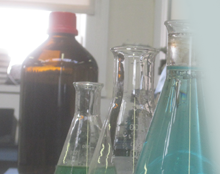Research
We are currently investigating the use of various lanthanide ions in medicinal chemistry. This includes the design and synthesis of macrocyclic based ribozyme and ribonuclease mimics, MRI agents and DNA intercelators, molecular beacons and luminescent sensors. Some of this work is also done in collaboration with Dr. Susan E. Matthews (University of East Anglia).
We are currently undertaking the design and synthesis of new macrocyclic systems as potential building blocks for ion and molecular recognition. This project, which is in two parts, consists of synthesising pyridine-based macrocycles as possible lanthanide luminescent probes and chiral tetraazamacrocyclic systems derived from simple a-amino acids as MRI contrast agents. We are also undertaking the synthesis of acyclic receptors that give rise to the formation of novel chiral lanthanide-based molecular architectures.
Work is being carried out on developing delayed Eu(III)/Tb(III) based macrocyclic systems as luminescent sensors/probes for cations, anions and neutral molecules. These sensors are based on a recognition site (receptor) which is covalently linked to a lanthanide-based emitting moiety (a Eu/Tb-complexed macrocycle). Prior to the ion sensing no lanthanide luminescence is observed and the system is thus ‘switched off’. However upon ion recognition the Eu/Tb emission is ‘switched on’.
We are undertaking the synthesis of linear and cyclic peptides for the detection of biologically important metal ions such as Cu2+, Ni2+, Na+, K+ and Li+ (drug measurements). Other work in this field involves the development of novel sensors to measure micro-cracks in bones. This work is carried out in collaboration with Professor Clive Lee (Royal College of Surgeons in Ireland) and Professor David Taylor (Trinity College Dublin).
We are currently developing simple fluorescent and colourimetric chemosensors for biologically important anions such as acetate, halides and phosphates. We have also developed fluorescent chemosensors for di-anions such as lactate and pyrophosphate. This work has been carried out in collaboration with Dr. Paul E. Kruger (Trinity College Dublin).
We are currently synthesising and evaluating the uses of chiral heterocyclic aromatic systems (such as naphthalimides) as fluorescent probes and as anti tumour agents. This work is carried out in collaboration with Prof. Mark Lawler (Trinity College Dublin), Prof. John M. Kelly (Trinity College Dublin) and the National Cancer Institute (NCI), U.S.A.
We have recently developed a photoionic (lanthanide luminescence) based logic gate, which mimics the function of semiconductor logic gates, used in modern computing.
We are carrying out research in collaboration with Prof. Suzi Jarvis (Trinity College Dublin) to develop novel sensors for biological systems to be incorporated onto surfaces.
Collaborations
We have established close collaborations with groups in Trinity College Dublin and other universities and institutions with the aim of achieving out targets.
Our collaborators are as follows:
Dr Paul E. Kruger
(University of Canterbury, Christchurch, New Zealand) Dr Susan Quinn
(Trinity College Dublin) Professor Mark Lawler
(Trinity College Dublin) Professor John M. Kelly
(Trinity College Dublin) Dr Colin P. McCoy
(Queen’s University Belfast) Professor Clive Lee
(Royal College of Surgeons In Ireland) Dr Susan E. Matthews
(University of East Anglia) Dr Stephen Faulkner
(University of Manchester) Professor Suzi Jarvis
(University College Dublin)
|



